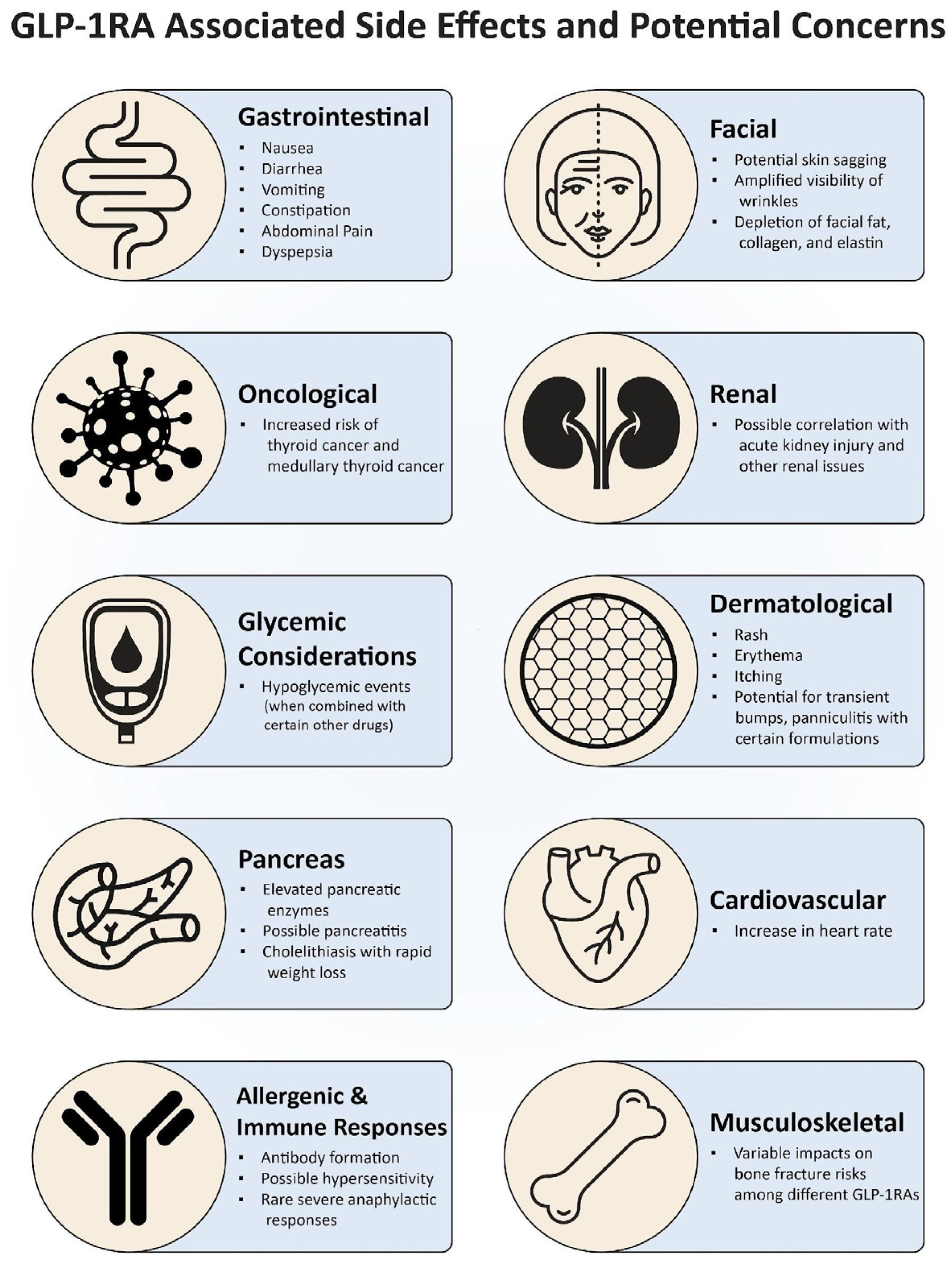
Glucagon-like peptide-1 (GLP-1) agonists belong to pharmacological use that helps to treat Type 2 Diabetes Mellitus (T2DM) and in some cases, support the weight loss journey among overweight adults. Many healthcare providers now suggest as effective weight loss and type 2 diabetes treatment drugs. Since ADA (American Diabetes Association) and FDA confirmed that apart from metformin in Type 2 diabetes management, Glucagon-like peptide-1 analogues give favourable results, especially in contraindication and metformin intolerance patients, so the use of GLP-1 agonists is highly preferred treatment in lower serum glucose levels or hypoglycemia. In 2023 ADA guidelines said that, alongside lower hypoglycemia and obesity, GLP-1 agonists are highly recommended drugs among patients with clinical ASCVD risks (eg, prior myocardial infarction, stroke), as they lower cardiovascular risk. Similarly, this class of medications were also very beneficial in decreasing chronic kidney disease (CKD).
 Now worldwide adult obesity has become a major public health issue in recent years, and alarming obese populations are growing day after day among adults. It could have adverse outcomes and lead to higher morbidity and mortality rates.
BMI anthropometric index (earlier called Quetelet index) measurement is commonly globally recognised as a biomarker to assess the risks of obesity.
A higher BMI index has developed many health risk factors; individuals with higher BMI or obese people have triggered some common health issues including premature mortality, cardiac diseases, high BP, worsened osteoarthritis, diabetes and in some cases cancers.
Now worldwide adult obesity has become a major public health issue in recent years, and alarming obese populations are growing day after day among adults. It could have adverse outcomes and lead to higher morbidity and mortality rates.
BMI anthropometric index (earlier called Quetelet index) measurement is commonly globally recognised as a biomarker to assess the risks of obesity.
A higher BMI index has developed many health risk factors; individuals with higher BMI or obese people have triggered some common health issues including premature mortality, cardiac diseases, high BP, worsened osteoarthritis, diabetes and in some cases cancers.
 Healthy or desirable body weight is highly influenced by daily lifestyles, eating habits, family history or genetics, metabolism rates, and physical activity (level of energy expenditure). However, keeping it well-maintained has become a significant health challenge among millions of people make every effort to achieve desirable results.
Globally, over 2 billion people are affected by obesity issues, which have reached record levels and are putting pressure on public health resources. There is a prevalence of obesity pharmacotherapy interventions or anti-obesity medications have gained attention in different ways to assist in weight loss.
Healthy or desirable body weight is highly influenced by daily lifestyles, eating habits, family history or genetics, metabolism rates, and physical activity (level of energy expenditure). However, keeping it well-maintained has become a significant health challenge among millions of people make every effort to achieve desirable results.
Globally, over 2 billion people are affected by obesity issues, which have reached record levels and are putting pressure on public health resources. There is a prevalence of obesity pharmacotherapy interventions or anti-obesity medications have gained attention in different ways to assist in weight loss.
GLP-1 was initially developed to treat type 2 diabetes:
:max_bytes(150000):strip_icc():format(webp)/GettyImages-1365257577-7f5be4653c114390832eb0aa7067652f.jpg)
Glucagon, a peptide hormone secreted from the alpha cells of the pancreatic islets, plays a major role in glucose metabolism and appetite regulation. Its relationship with Peptide-1 receptor agonist (GLP-1 RA) drugs has gained interest among a large number of people due to their effective therapeutic drug in managing metabolic health. These medications emulate the action of GLP-1, a key hormone released during food intake that contributes to feelings of a state of fullness or leaves you more satiety. Initially, these medications were developed for the treatment of type 2 diabetes mellitus, but GLP-1 RA drugs have demonstrated remarkable outcomes in clinical settings. Studies show that patients can experience significant weight reductions of around 5% to 15% within a year of treatment. This weight loss is not merely an aesthetic benefit; it represents a substantial reduction in obesity-related health risks. These GLP-1 agonists — now commonly referred to as anti-obesity drugs — have been making large-scale trajectories in weight-loss results, and the need for such solutions has been so urgent. According to the CDC (Centers for Disease Control and Prevention), the prevalence of obese population in the U.S. has surged alarmingly from 30.5% in 1999–2000 over 41.9% in 2017–2020. This staggering increase highlights a critical public health issue that demands immediate attention.
Similarly, adult obesity rates in England have put us in another shock!

In 2022, a Health Survey for England (HSE) report has completely caught off our guard. The findings are a wake-up call that we cannot afford to ignore. That estimated 28% of adults are classified as obese and another 36% as overweight, the public health has gone through major challenges. On an alarming note, men are at greater risk (67% of men are falling into these categories, compared to 61% of women) more likely than women. Understanding obesity requires more than just numbers; it is vital to grasp its definition—specifically, obesity is defined as a body mass index (BMI) is ≥30. Slightly different from “overweight’, where BMI ranges fall between 25 kg/m² and 30 kg/m² per person.
Source: NHS Digital, Health Survey for England 2022,
Between 1993 and 2022, the percentage of overweight or obese adults in England increased from 52.9% to 64.3%, and obese adults rose from 14.9% to 28.9%. As the popularity of GLP-1 receptor agonists (GLP-1 RAs) continues to rise, over 15 million obese patients are getting benefits. Forecasts suggest that by the end of this decade, over 30 million Americans will embrace GLP-1 RA treatments to combat obesity and its associated health risks. In European countries, overweight and obesity categories have massively reached an epidemic stage, which is more predominantly observed in men (63%) than women (54%). Wealthier nations often have higher prevalence rates, while the Mediterranean and Eastern European countries show the most overweight and obese people.What are the applications of Glucagon-like peptide-1 (GLP-1) agonists?
As mentioned earlier, pharmacological use of GLP-1 agonists is primarily taken to treat T2D and obesity, and they have impactful effects to achieve in desired results to regulate plasma glucose levels, they also reduce hunger and suppress daily calorie intake.How do GLP-1 agonists help our body control obesity and treat patients with T2DM?
Let’s understand below, how does GLP-1 hormone work. Your small intestine produces the hormone GLP-1. Among its many roles are: Stimulate insulin secretions from your pancreas: Insulin is an anabolic hormone that converts your food into (a source of) energy in your body. It lowers hyperglycemia ( blood glucose) effects and allows glucose to enter into cells. If your body can’t produce enough insulin, your blood sugar spikes rapidly (hyperglycemia), causing you to have diabetes.- Blocking glucagon action: This GLP-1 helps you prevent instant blood sugar spikes and control glucose homeostasis or blocks glucose transport into your bloodstream.
- Reduce appetite: Trigger slow digestible carbohydrate activities, which means your body gets less plasma glucose from your food and releases less sugar into your bloodstream.
- Feel full after small meals: GLP-1 receptors affect the hypothalamus area of the brain, which triggers hunger and satiety.
GLP-1 agonists directly linked to a serious condition is hypoglycemia:
Low blood sugar is a greater concern with GLP-1 agonists. That condition is medically termed hypoglycemia. One clinical case-control study found that GLP-1 receptor agonists trigger hypoglycemia cases, and vulnerably affect middle-aged patients over elderly ones. Also, found that female participants were more affected than their male counterparts. On note, GLP-1 receptor agonists aren’t advised for individuals who:- Have had Neuroendocrine tumours (NETs) or medullary thyroid cancer or have a genetic predisposition to the disease.
- Have affected by multiple endocrine neoplasia or have a genetic predisposition to the disease.
- Have had acute pancreatitis.
- Expecting a baby or childbearing woman.
- During breastfeeding.

We can’t avoid mentioning this report by the Medicines and Healthcare products Regulatory Agency, Published on 24 October 2024, which is obvious to know and supports our claim. Till October 28, 2024, the MHRA had received 7228 reports linking GLP-1RAs (used for weight loss) to nausea, vomiting, and diarrhoea. Among them, in 68 of the reports, the individual’s hospitalisation was noted. Other than common Gastrointestinal side effects of GLP-1 drugs, is “Ozempic face” is one common side effect of GLP-1 drugs, and this could be caused due to rapid weight loss.
 Facial fat pads shrinking can lead to:
Facial fat pads shrinking can lead to:
- a hollowed cheeks or sunken appearance
- under-eye hollows
- in face tissue thickness
- skin folds or deep facial ridges
- loose skin on your chin or jawline
To all my health-conscious friends!
 Why not try something natural compounds to support your diabetes journey or weight loss goal?
What you face may look unconquerable, but what you read here, as always, helps you out on your blood glucose control battle. Because persistent spikes can cause significant health risks.
Look at the wonderful nutrient-rich naturally supporting diabetes management supplement “Ultimate Gluco Support“.
This plant-based chromium 25mg is packed with bioavailable perennial vines of Gymnema sylvestre, a buffer to support glucose metabolism and healthy cholesterol levels. It’s said to have an important effect on insulin responsiveness while also protecting against oxidative stress, support to increase in serotonin levels and maintain steady serum cortisol levels.
Alongside, this supplement has Fenugreek, scientifically known as Trigonella foenum-graecum. This potent herb has immense nutraceutical values and has been historically used for various disorders such as diabetes, high cholesterol, wound healing, inflammation, and gastrointestinal ailments.
Moreover, it’s highly effective and helps in reducing postprandial glucose and plasma insulin concentration— want to be a healthy person of your age, try this today.
And let me get started on Cinnamomum verum, also known as Ceylon cinnamon. This dietary supper herb contains biologically active substances that have been shown to regulate plasma glucose concentration via insulin secretion from pancreatic β-cells.
In simpler terms, it may help with blood sugar management by increasing insulin sensitivity and lowering blood sugar levels after your daily meals.
Why not try something natural compounds to support your diabetes journey or weight loss goal?
What you face may look unconquerable, but what you read here, as always, helps you out on your blood glucose control battle. Because persistent spikes can cause significant health risks.
Look at the wonderful nutrient-rich naturally supporting diabetes management supplement “Ultimate Gluco Support“.
This plant-based chromium 25mg is packed with bioavailable perennial vines of Gymnema sylvestre, a buffer to support glucose metabolism and healthy cholesterol levels. It’s said to have an important effect on insulin responsiveness while also protecting against oxidative stress, support to increase in serotonin levels and maintain steady serum cortisol levels.
Alongside, this supplement has Fenugreek, scientifically known as Trigonella foenum-graecum. This potent herb has immense nutraceutical values and has been historically used for various disorders such as diabetes, high cholesterol, wound healing, inflammation, and gastrointestinal ailments.
Moreover, it’s highly effective and helps in reducing postprandial glucose and plasma insulin concentration— want to be a healthy person of your age, try this today.
And let me get started on Cinnamomum verum, also known as Ceylon cinnamon. This dietary supper herb contains biologically active substances that have been shown to regulate plasma glucose concentration via insulin secretion from pancreatic β-cells.
In simpler terms, it may help with blood sugar management by increasing insulin sensitivity and lowering blood sugar levels after your daily meals.
